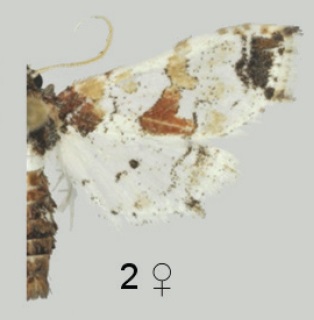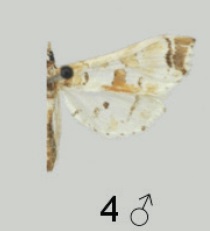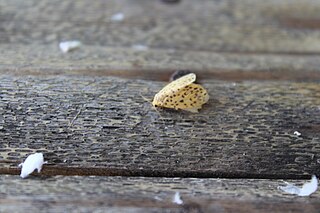
Udea ferrugalis, the rusty dot pearl, is a moth of the family Crambidae. The species was first described by Jacob Hübner in 1796.

Evergestis frumentalis is a moth of the family Crambidae. It is found from the Iberian Peninsula through southern and central Europe and southern Fennoscandia to central Asia and southern Siberia. The species was first described by Carl Linnaeus in 1761.
Afroscoparia is a genus of moths of the family Crambidae, the grass moths. It was established in 2003 to provide a new name for a Scoparia species, now Afroscoparia contemptalis. At the same time, A. australis was described.

Hymenia perspectalis, the spotted beet webworm moth, is a species of moth of the family Crambidae. It is found in various parts of the world, including North America, where it is found from Maine to Florida, west to Texas and north to Michigan and Ontario. It is also found in Belize, Hong Kong, Jamaica, Australia (Queensland), the Comoros, Equatorial Guinea, Réunion and South Africa. The species was described by Jacob Hübner in 1796.

Leucinodes laisalis is a species of moth in the family Crambidae.

Scopariinae is a subfamily of the lepidopteran family Crambidae. The subfamily was described by Achille Guenée in 1854.
Nymphicula perirrorata is a moth in the family Crambidae. It was described by George Hampson in 1917. It is found in Ghana, Ivory Coast, Malawi, Nigeria, Sierra Leone, South Africa, Sudan and Zimbabwe.

Eoophyla capensis is a moth in the family Crambidae. It was described by George Hampson in 1906. It is found in Angola, Cameroon, Ethiopia, Kenya, Liberia, Malawi, Mozambique, Namibia, Nigeria, South Africa, Tanzania, Uganda, Zambia and Zimbabwe.
Eoophyla scioxantha is a moth in the family Crambidae. It was described by Edward Meyrick in 1937. It is found in the Republic of the Congo, the Democratic Republic of the Congo, South Africa and Zambia.
Patissa virginea is a moth in the family Crambidae. It was described by Philipp Christoph Zeller in 1863. It is found in the Democratic Republic of the Congo, Mozambique, South Africa, Taiwan, India and Sri Lanka.
Afroscoparia contemptalis is a moth in the family Crambidae. It was described by Francis Walker in 1866. It is found in South Africa, where it is found in the south-western part of the Western Cape Province.
Afroscoparia malutiensis is a moth in the family Crambidae. It was described by Koen V. N. Maes in 2004. It is found in Lesotho.

Microtheoris ophionalis, the yellow-veined moth, is a moth in the family Crambidae. It was described by Francis Walker in 1859. It is found from southern Canada, through the United States and Mexico to South America.

Leucinodes africensis is a species of moth in the family Crambidae. It is found in West Africa, Angola, the Democratic Republic of the Congo, Gabon and Tanzania. It has been intercepted with plant imports from Ghana and Zimbabwe to Great Britain and the Netherlands. The species was described by Richard Mally, Anastasia Korycinska, David J. L. Agassiz, Jayne Hall, Jennifer Hodgetts and Matthias Nuss in 2015.

Leucinodes rimavallis is a species of moth in the family Crambidae. It is found in Burundi, eastern and southern Democratic Republic of the Congo, Kenya, Rwanda, South Africa and Uganda. The species was described by Richard Mally, Anastasia Korycinska, David J. L. Agassiz, Jayne Hall, Jennifer Hodgetts and Matthias Nuss in 2015.

Leucinodes pseudorbonalis is a species of moth in the family Crambidae. It is found in Angola, Senegal and Uganda. The species was described by Richard Mally, Anastasia Korycinska, David J. L. Agassiz, Jayne Hall, Jennifer Hodgetts and Matthias Nuss in 2015.

Leucinodes cordalis, the poroporo fruit borer or eggfruit caterpillar, is a species of moth in the family Crambidae. It is found in New Zealand, Australia and Indonesia (Sulawesi). In Australia, it has been reported from Norfolk Island, the Northern Territory, Queensland, New South Wales, the Australian Capital Territory, Victoria, Tasmania and South Australia. The species was first described by Henry Doubleday in 1843.
Penestola bufalis, the black penestola moth, is a moth in the family Crambidae. It was described by Achille Guenée in 1854. It is found in the US states of Texas and Florida, as well as on the Antilles. It is an accidentally introduced species on the Galápagos Islands. The habitat consists of coastal mangrove swamps and shorelines.

Polygrammodes eleuata, the red-spotted sweetpotato moth or many-spotted moth, is a moth in the family Crambidae. It was described by Johan Christian Fabricius in 1777. It is found in Central and South America, on the Antilles and in the southern United States, where it has been recorded from Florida.
Sufetula diminutalis is a snout moth in the subfamily Lathrotelinae of the family Crambidae. It was described by Francis Walker in 1866 in the genus Isopteryx from material collected in Honduras.










